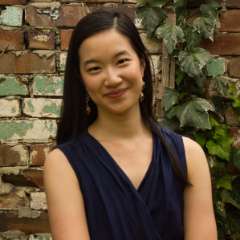The three grand paper fans drawn across the stage curtains indicated the gorgeous, oriental sweep to follow in Graeme Murphy’s Turandot. The 1990 production has graced the Opera Australia stage for almost thirty years and, for its age, it remains moving and verdant. It has the distinction of being one of the many wonderful collaborations between Murphy and the late, great designer Kristian Fredrikson. Theirs was one of the mosts electric combinations in the Australian arts scene, and Turandot reminded me again of how much I miss their combined vision.
Set in Fredrikson’s storybook kingdom of lacquer, iron, and silk, the production bears Murphy’s signature instinct for visual spectacle and emotional warmth. There is unashamed emphasis on movement – almost unusually so for an opera. Murphy’s Turandot reigns over a bustling, vibrant kingdom alive with long-sleeved mandarins hurrying about court business, masses of trudging peasants, and silk banners waving above flanks of armoured guards, all compellingly brought to life by Opera Australia's chorus. The effect of this visual dynamism was to hint that a full and vivid world lived and breathed behind the proscenium arch, and that it was only by entering that we would truly hear Puccini’s music for what it was. In other words, if Puccini was said to have first heard Turandot’s folk melodies in an old Chinese music box, then Murphy and Fredrikson have made a point of lovingly recreating that box.
Opening night for this revival was conducted by Christian Badea, who led with a discerning sense of pacing and drew an exceptionally elegant sound from the Opera Australia Orchestra.
American soprano Amber Wagner returned to the Australian stage as Turandot. The role demands infamous amounts of vocal heft, endurance, and brilliance of sound. But Wagner – blessed with a formidable, soaring voice literally fit for a princess – was both undaunted and excellent. The Act 2 riddles and “In questa reggia” were highlights, showcasing her gleaming tone, fearless and powerful vocal outpouring, and steely dominance over the tightrope-high (and tightrope-clean) money notes.
Turandot’s narrative arc is equally difficult to execute, with even the near-death Puccini wondering how to credibly turn her from a murderous despot to blushing bride. Wagner’s vocal acting through the crucial Act 3 transformation was compelling, but her physical mannerisms were not as convincing; particularly when juxtaposed against the pleasingly natural style of Andeka Gorrotxategi’s Calaf. She is relatively new to the role though and I look forward to seeing her Turandot achieve a dramatic expression at level with her magnificent vocal prowess.
Spanish tenor Gorrotxategi sang Calaf with a smooth, warm and burnished tone and a reassured sense of control. His physical characterisation was refreshing for its unaffected naturalism. While his lower register could not always be heard clearly above the orchestra, he demonstrated pleasing strength in his upper range – a necessity in the Act 2 duet, and especially with Wagner. “Nessun dorma”, sung in a spectacular landscape of billowing silk mountains, was lyrically phrased but felt pushed in places and held back in others, unlike the flowing energy of his Act 2 and 3 duets.
Mariana Hong was a winning audience favourite as the sympathetic Liù. While the role can be sung with a softness contrasting Turandot’s power, Hong’s voice had a vibrant clarity and youthful resonance reflective of the character’s purity and sacrificial strength of character. Richard Anderson brought pathos and gravitas to Timur.
In an opera where there is otherwise little comic relief, Acts 1 and 2 were almost stolen by Ping, Pang, and Pong (Christopher Hillier – whose voice was especially delightful, Virgilio Marino, and John Longmuir). The trio handled the energetic choreography whilst maintaining vocal integrity and winning audience laughs; all flapping sleeves, pointed fingers, and inventive dancing with scrolls.
Which brings me to my main impression of this Turandot – safe to draw now that the production is almost three decades old. While opera has always been about the music, Murphy’s visual focus proves that – in the right hands – properly considered movement enhances an audience’s listening pleasure. Would we have heard the lyrical phrasing and timbral contrast of the children’s chorus as keenly, had their musical entrance not coincided with their theatrical entrance in long, weaving lines? Would we have perceived the musical structure of the three riddles as acutely, had each section’s ending not been represented by tearing silk? And would we have experienced Ping, Pang and Pong’s harmonies as clearly, had their bird-like head movements not coincided with musical accents? For most of us, probably not. Doubtless certain operas gain power from visual sparseness (last year’s Lucia di Lammermoor comes to mind). But Murphy’s Turandot proves that for certain works, an even greater beauty can be heard in the music when the visual imagination is given equal consideration.




